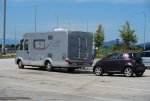The problem with the alternative drive and power systems isn't the manufacturers of the units, its convincing the road haulage industry to try it!
They want reliable cost effective trucks,and most companies wouldn't want to be the 'first' fleet user to buy a few,they'd rather wait for someone else to try them, to get all the bugs ironed out.
They cannot afford to risk the financial consequences if they didn't cope with the demands of long distance travel, remember most hauliers run them nearly 7 days a week,52 weeks a yr,so reliability and efficiency is paramount.
Of course,until you get a few on the rd,in real work situations,you won't know how good/bad they are.
Vicious circle.
Optimusprime!
I believe you are wrong!
Especially in the road haulage industry - there are always a few (....likely VERY few) that do the final road-testing for the developers, they will have conventional back-up for the units and financial support from the developers too - we just don't know who they are!
The same would have applied to the Hydro-Drive!
Quarry/Building-Site - trucking is possibly even more cut-throat than long-haulage....
Just the thought of multiple hydraulic systems on the truck would have shocked operators - so for sure someone was "supported" to try it!
This are all systems for the long-run in business so a year or two of clandestine road testing is just a small sacrifice, but incredibly valuable!
Unfortunately no way to proof it, but I bet you, the Bosch-System was run on the highway at least for some 12-18 months under real-world conditions, by a "everyday/average" operator at no cost to him, butfor bringing in extensive reports.
What did he gain? An edge for quite few month over his competition!
And that BEFORE the system ever saw the public
And most likely he will be first in line for the next big thing!
Cheers,
thjakits
They want reliable cost effective trucks,and most companies wouldn't want to be the 'first' fleet user to buy a few,they'd rather wait for someone else to try them, to get all the bugs ironed out.
They cannot afford to risk the financial consequences if they didn't cope with the demands of long distance travel, remember most hauliers run them nearly 7 days a week,52 weeks a yr,so reliability and efficiency is paramount.
Of course,until you get a few on the rd,in real work situations,you won't know how good/bad they are.
Vicious circle.
Optimusprime!
I believe you are wrong!
Especially in the road haulage industry - there are always a few (....likely VERY few) that do the final road-testing for the developers, they will have conventional back-up for the units and financial support from the developers too - we just don't know who they are!
The same would have applied to the Hydro-Drive!
Quarry/Building-Site - trucking is possibly even more cut-throat than long-haulage....
Just the thought of multiple hydraulic systems on the truck would have shocked operators - so for sure someone was "supported" to try it!
This are all systems for the long-run in business so a year or two of clandestine road testing is just a small sacrifice, but incredibly valuable!
Unfortunately no way to proof it, but I bet you, the Bosch-System was run on the highway at least for some 12-18 months under real-world conditions, by a "everyday/average" operator at no cost to him, butfor bringing in extensive reports.
What did he gain? An edge for quite few month over his competition!
And that BEFORE the system ever saw the public
And most likely he will be first in line for the next big thing!
Cheers,
thjakits




